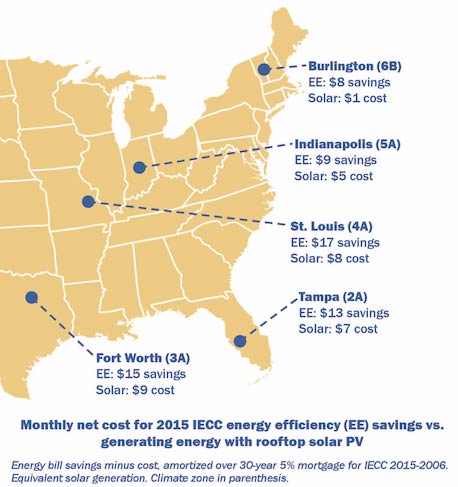In a Pinch, Choose Energy Efficiency Over Solar
Energy-efficient windows and more insulation will save homeowners more than PV in the long run.

by Christopher Perry
An analysis by the American Council for an Energy-Efficient Economy finds that energy efficiency and solar make complementary energy and carbon reductions in new home construction, but when budgets are tight, efficiency needs to come first. Throughout the United States, energy efficiency is more cost-effective. Each month, it delivers $4 to $32 in net savings while rooftop solar alone can cost up to $14.
With the U.S. building stock estimated to add a net average of 1.4 million homes each year, states will need to minimize their energy use and greenhouse gas emissions by focusing on effective building codes and standards. For the U.S. residential sector, building codes like the International Energy Conservation Code (IECC) and voluntary labels like Energy Star provide cost-effective guidance for insulation, windows, lighting, and heating and cooling equipment to construct efficient and sustainable homes.
Our research paper and summary show that the energy efficiency measures found in these codes and standards are more cost-effective than an equivalent amount of energy generated from photovoltaic (PV) panels. Based on these results, we conclude that new homes must first be built efficiently for maximum cost-effectiveness. Solar panels can then be added to further reduce carbon emissions and help homes meet zero-energy targets.
States adopting residential building codes need to consider these results when assessing proposals to allow solar PV to be substituted for energy efficiency measures. Requirements like efficient windows and wall insulation help ensure long-term cost-effective energy savings for the homeowner. Solar panels can cost more, and may be dependent on financial arrangements. Even if a homebuilder can save upfront costs through financing options tied to government incentives, the homeowner will not necessarily save money in the long term.
The following graphic compares the monthly net costs for energy efficiency to meet the 2015 IECC code and equivalent solar PV generation, for cities in Climate Zones 2-6, an area reaching from the hot and humid South to the cold North. Net monthly efficiency cost savings are even greater for homes built to Energy Star standards. These results do not include government incentives and assume a traditional mortgage rather than other financing.

Of course, cost-effectiveness isn’t the only consideration when installing efficiency measures or solar panels. Both reduce heat-trapping carbon emissions and harmful air pollution. Plus, a well-insulated, efficient home loses and gains heat more slowly than a drafty one, helping to retain comfortable temperatures during emergency power outages. Similarly, when PV is paired with battery storage, it can provide a homeowner with electricity during a power outage.
Efficiency measures work around the clock
When it comes to improved health and comfort, insulation combined with high-efficiency windows and air conditioning systems have an advantage over PV. They also typically reduce peak power demand, whereas solar power can reduce peak demand mid-day, but this benefit fades as the sun sets, so the grid needs to ramp up quickly to meet demand. On the other hand, installing rooftop solar panels is a great way to signal a clean energy commitment to the world, while efficiency measures like insulation and efficient water heaters typically remain hidden.
Solar energy and energy efficiency are both key parts of our energy future. For example, solar and efficiency together can help meet ambitious zero-energy building targets, like California’s Residential New Construction Zero Net Energy (ZNE) Action Plan.
When it comes to constructing a new home throughout most of the United States, our study shows that energy efficiency is the most cost-effective choice. Once a home achieves compliance with energy codes through energy efficiency, then solar can help meet the remaining energy load.
Christopher Perry is a senior analyst in the Buildings Program at the American Council for an Energy-Efficient Economy. This post originally appeared in the ACEEE News & Blog section.






View Comments
This appears to apply to new construction. Is there data comparing adding solar panels versus replacing old windows with triple pane on an existing structure.